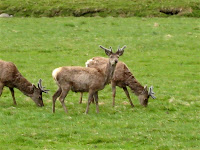There are monuments all over the Highlands commemorating the 'last wolf', but it is generally agreed that the last wolf was actually killed by a man called MacQueen on the upper reaches of the River Findhorn in the year 1743. A lone wolf had attacked a woman and her children so the young laird and clan chief, Angus Maclntosh of Moy, arranged a "tainchel" or gathering to hunt it down. MacQueen, a well-known hunter, was ordered to attend; having asked a few questions about the alleged attack and sightings of the wolf, he promised to be there.
On the day Maclntosh and the local men gathered promptly at Moy Hall, but MacQueen made a casual and belated entrance, dogs at his heel. He was upbraided for his lateness by a scowling Maclntosh.
“Ciod e a chabhag?” “What was the hurry?” came the nonchalant response. MacQueen then lifted his plaid and drew forth the bloody head of the wolf, which he tossed at the laird's feet.
I passed the place a couple of weeks ago. But sadly the Moy Hall of that day burnt to the ground in 1800. It had, unlike so many others, survived the Battle of Culloden and its aftermath. The clan, recruited by his glamorous wife Anne, was 'out' at Culloden, but Angus MacIntosh himself (most strangely to our 21st century eyes) was on the opposing side having become a Captain in the British Army. Not a bad call as it meant that his home was safe.
The wolf would not have believed his eyes today - the green
flood plain of the Upper Findhorn was covered in several hundred deer, almost delicate in their part grown velvet covered antlers!
Further up near Coignafern the river was alive with noisy waders but we failed to see the small herd of wild goats that is normally there or even the golden eagles so beloved of landlord Sigrid Rausing, millionairess and enthusiasatic environmentalist.
Further north at Alladale estate, another landowner with plenty spare cash, Paul Lister has big plans for his 23,000 acre estate. He is going to reintroduce elk, lynx, bear, bison and... wolves.
Goodness knows what MacQueen would have made of it all!





















































